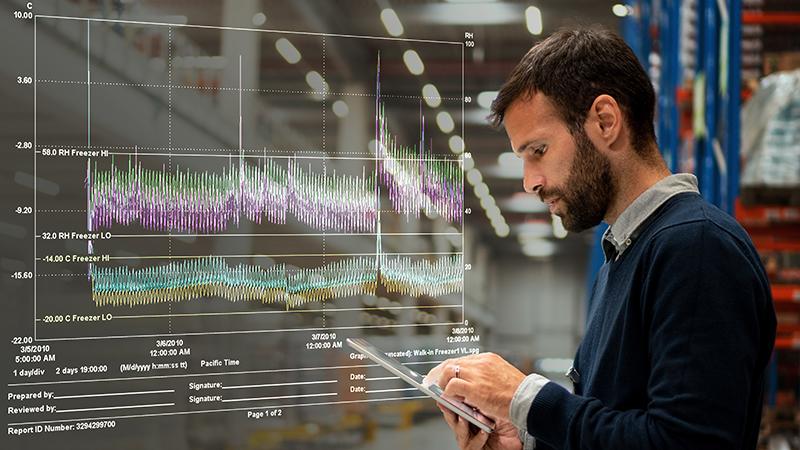Temperature Mapping Study Design, Duration & Intervals
In this video blog, two validation experts answer questions on best practices for mapping study design, including sensor placement, study duration and sensor calibration intervals. Please find the transcript below.
These questions came from our webinar "Controlled temperature chambers: Qualification, mapping & monitoring", which you can watch at any time...
Question: Can you discuss best practice for monitoring sensor placement? What guide do you follow for the distribution of sensors and which guide is the most recommended or accepted in industry?
[00:01:58]
Paul Daniel: Sensor placement, whether for mapping or monitoring, is really one of the most commonly asked questions. It really requires some critical thinking and experience to answer it well. There are two good guides, the first is from the ISPE, which gives you some models that can be extrapolated to reality situations using some critical thinking about the risk factors involved.
Your other guide is from the WHO, which also gives you some models that you can extrapolate to reality. But you really need to recognize that while both of these bodies are respected sources of guidance, they have very different audiences. You know, the ISPE is focused on GxP manufacturing primarily and really has an expectation that your organization has an entire set of controls based in a mature quality system to support risk based analysis and critical thinking.
On the other hand, the World Health Organization is more global; their guide is designed for drug manufacturing and distribution in economies that may lack robust regulatory oversight. The audience also includes companies that have fewer resources to support quality management strategies. These recommendations are often simpler but higher in the number of recommended sensors.
I recommend you watch the Vaisala webinar on mapping sensor placement. In this webinar, we go in-depth into sensor placement for mapping and monitoring sensors. What do you think, Nate?
[00:03:48]
Nathan Roman: I think that the WHO and ISPE guidelines do specify and provide common practices in sensor placement for for monitoring systems. And I know that the manufacturer's control probe positions are critical because this governs the system's temperature control response. Manufacturers typically choose that location to represent the chamber's average temperature.
The average temperatures provides a reference for overall temperature control performance, but it's also essential to consider the typical loading pattern in the chamber when placing the sensors. While monitoring sensors are crucial for detecting emergencies, a well distributed sensor placement strategy offers comprehensive insights on the temperature profile of the chamber under normal and worst-case conditions in monitoring.
[00:05:11]
Paul Daniel: I think it's important to remember that while every chamber is different, you can create logistical problems if every chamber has its monitoring sensor location in a different place. I know from experience with pharmaceutical facilities, almost every time that you open a refrigerator or a freezer, the monitoring probes are in the same place, typically right inside the unit on the same side as the door handle, maybe 8 or 10 inches inside to capture the event of a door left open.
I think its a misunderstanding of Good Distribution Practice misunderstanding to place a monitoring sensor at the hotspot, because the hotspot is going to be in a different place in every in every chamber. This could create a logistical nightmare. However, a warehouse is where we can begin to consider hotspot location monitoring...
Question: What are the ideal intervals for calibration and mapping activities?
[00:06:34]
Paul Daniel: Mapping can be repeated every six months to five years, depending on chamber type and application criticality. There's a new recommendation from the ISPE that's moved toward periodic performance evaluations to determine if remapping is necessary or helpful. Nate and I actually worked on that guide together. What's your thoughts about intervals for mapping activities?
Nathan Roman: I'm on the same page as you, Paul. The ideal time duration for calibration and mapping activities depends on the specific application risk assessment and the regulatory requirements. Calibration is typically performed, as you said, every six to 12 months. For temperature mapping frequencies, I typically have seen three to five-year revalidation cycle, or annual temperature mappings.
However, mapping frequency may vary based on the risk assessment or historical performance data. But there's no hard, fast regulation that I know of applicable for the time frame that they're asking about. New guidance does suggest that controlled temperature chambers should be periodically assessed to determine the need for revalidation or remapping the control systems equipment. The monitoring trend data, calibration, and preventative maintenance records, as well as operational procedures for the unit should be a part of that periodic review to ensure that that unit is still in a qualified state.
[00:08:35]
Paul Daniel: I agree completely. Some people will find that it's easier to remap the environment than to go through a risk assessment, especially if we're just talking about a refrigerator. With a warehouse, it's much harder work. So you'll want to do the risk assessment, but you might just want to go ahead and remap that fridge every few years and and and skip that assessment process to save yourself some time.
The question also involved calibration and it's hard for me to tell if that question was about pre and post calibrations in mapping, or normal device calibration. In my experience, most companies default to the manufacturer's recommended calibration interval, which is usually six months to one year. Most adjust their calibration frequency based on sensor performance.
What do you think about pre and post-calibration intervals, Nate? I mean, I know you want to have them as close as possible to have the least amount of risk. But do you find that as you gain familiarity with your mapping system or you have higher quality sensors that you can lengthen those intervals?
[00:09:57]
Nathan Roman: So I used to always do the pre and post calibrations because I was using thermocouple-based systems. Once I started using the the Vaisala data loggers with the thermistor sensors, I stopped the pre and post calibrations. I recall that it was many years ago that I reached out to you to ask about this. I reached out to you for some justification around skipping the pre and post calibration work. I was guided by what you told me about thermistors versus thermocouples...
[00:11:24]
Paul Daniel: That brings back some memories! I recall that we discussed the statistics we have from our own calibration data of our loggers. With those loggers, we have seen that 98% of the time, those loggers would come in for calibration without any need for adjustment. That has allowed us to offer a high degree of confidence, even after a year in the field.
Granted, when they're getting banged around a lot, it's not quite the same, but there are good reasons to have confidence in them. Thermistors have a logarithmic relationship electronically to temperature change. So if something's going to be off, it's going to be way off. A post-study calibration can be a lot more like a simple reality check. Many Vaisala customers are mapping service providers. These are vital customers and we've learned that they are fairly liberal with their pre- and post-calibrations because they've learned that they can rely on the the stability of a Vaisala data logger.
[00:12:34]
Nathan Roman: But I will say I'll jump in real quick to say that there are customers that still require the pre- and post-calibration, even if I use the thermistor-based data loggers. This is ingrained thinking from many years of including those steps in their mapping processes.
Question: How long do we perform an open-door test? Also, what should be the standard duration for mapping?
[00:13:26]
Paul Daniel: I'll answer the question about the standard duration for a mapping study. There are no standards, but there are recommendations from guidance and some established practices. In my experience, I insist on a minimum of 72 hours for a chamber and at least one or two weeks for a warehouse.
In some guides, we see something like 24 to 48 hours for a chamber or a week for a warehouse. But the more data, the better. I think there's no reason to hurry when you've invested in sensor deployment. I'm going to hand that back to you, Nate, and give you the open-door test because we both know that I don't like door open tests.
[00:14:10]
Nathan Roman: So based on the industry best practices, the the duration for open-door tests should be decided upon by going through a risk assessment and coming to consider the operational requirements for your specific CTU (controlled temperature unit) or cold room or what have you. Typically, those tests are conducted for a time period that's long enough to represent a worst case scenario, such as a door being open for too long. But for the open-door test, the the time period would be anywhere from 5 to 15 minutes. And then following that, the recovery time of the chamber is observed and monitored once the door is closed.
The true objective of the open-door test is to assess the stability and the resilience of the temperature within the chamber in case of such events. In real life scenarios, with the door being open too long, it's not just about the door being opened; the key issue is how quickly and efficiently the chamber can recover to the acceptable temperature range once the door is closed again. Although gathering the data can be useful for future incidents, it's crucial to consider preventative measures, like employee training or having some automatic door closing mechanism as part of a comprehensive risk mitigation strategy. If you're storing critical products or materials, the effects of a door being open too long could be significant. This is why we we do those tests. But I know, Paul, you had mentioned a second ago that you don't like the open-door test...
[00:16:21]
Paul Daniel: Exactly. I don't consider it to be a legitimate validation because there's no specification to develop acceptance criteria. But I agree that once you've got the sensors deployed, it's a good time to collect this data. But the tests must be reported in some document. And so a validation protocol is a good place to put it. I really love that you added to your answer that it's not just about how long the door can be open before temperatures go out of specification, it's really about recovery time to specified temperatures. This data can be really important in the future for investigating temperature deviations and excursions. The tests can prove that you've protected your product. So while the open-door test is a GMP activity, it's a pet peeve of mine when it gets called validation or qualification. People deserve to know why don't like it because I don't want them to be biased against the door open tests. I'm just old school.
[00:17:26]
Nathan Roman: I get it, but I want to jump in real quick. I know you touched on the standard duration for mapping, but I'd like to mention that the duration for mapping obviously varies depending on the stability of conditions, or the equipment being mapped. For freezers, refrigerators, and incubators, a common practice is performing a 24-hour study to thoroughly capture the temperature performance and stability. As you said, that time can be extended, but my experience has been 24 hours for for the typical CTU, and for a cold room or walk in, I do a 3-day mapping. For warehouses, it would typically be a seven-day, or 168-hour temperature study.






Add new comment